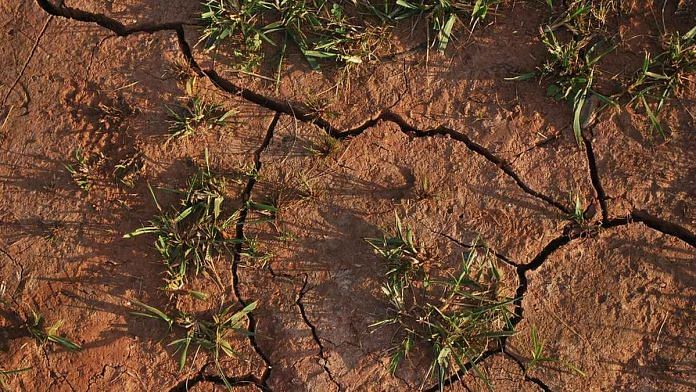New Delhi: Climate change is turning India’s agricultural calculations on their head, and threatens to upturn harvests unless an effort is made to adapt, a study has suggested.
Conducted by researchers at the India Meteorological Department (IMD), the one-of-its-kind study was published last week in Current Science journal.
The report seeks to detail changes in climatic conditions, including temperature and precipitation, over the past three decades, and how they have affected India’s farmlands.
Different areas, different impact
Throughout human history, civilisations across the world have devised agricultural practices to best match the weather and climate of that particular region.
In the 1990s, the Indian Council of Agricultural Research (ICAR), New Delhi, divided the country into 127 “agroclimatic” zones, categorised on the basis of soil type, climate (temperature and rainfall), topography, vegetation etc.
These estimates help decide what crops to sow in a certain area, and at what time of the year.
However, as temperatures rise due to increasing greenhouse gas emissions, the climate is changing. Since this change is heterogeneous, the impact varies from one place to the next: While it may manifest in heavier rainfall in one area, it could mean less precipitation in another.
Owing to this, the study concludes, the current agroclimatic classifications need to be reconsidered to optimise harvests.
While earlier studies have focused on the effects of climate change at the national and state level, the researchers note that “not many studies have been carried out at the agroclimatic zone level where specific crops are grown based on the region-wise characteristics”.
“…Any change in climatic parameters, particularly temperature and rainfall, in the agroclimatic zones will have a significant bearing on the existing agroclimatic classification as well as crop production,” says the study.
Study findings
The study found a warming trend in several agroclimatic zones of the Northeast — according to the researchers, in most of these areas, there was a 0.04-0.05°C per year rise in the mean maximum temperature, on the annual as well as the seasonal scale.
The increase ranged from 0.01 to 0.03°C per year in agroclimatic zones of Jammu and Kashmir and the south. Tamil Nadu was an exception, with its western and northwestern zones showing cooling trends of -0.01 to -0.03°C per year on the annual scale.
The zones of central and western India showed very little change in maximum temperature on the annual scale, though a significant cooling trend was observed in the peak winter months of January-February in Gujarat, Madhya Pradesh, Haryana, Punjab, Uttar Pradesh, and Rajasthan.
The mean minimum temperature shows little variation across the country, except during monsoon months, when most states register a significant increasing trend on this count. These include Karnataka, Bihar, Jharkhand, Gujarat, Himachal Pradesh, Jammu & Kashmir, and Uttar Pradesh.
Shifting monsoon
This study also notes large variations in the way climate change has affected rainfall in different regions.
India’s weakening monsoon has been well-documented in recent years.
The IMD study derives similar conclusions, noting a decreasing trend in monsoon rains in the Himalayan foothills, up to Jammu & Kashmir and most regions of the northeast. The agroclimatic zones in Gujarat and Rajasthan, however, exhibit an increasing trend in monsoon rains.
While the number of rainy days per monsoon have decreased in several areas of the northeast, they have gone up in large parts of central, western, and southern India, the study found.
According to the study, the post-monsoon time, which represents the main rainy season for many southern states, exhibits a decreasing trend in northern Tamil Nadu, parts of Odisha and adjoining West Bengal, eastern Uttar Pradesh, Punjab, Haryana, and the hilly regions of Jammu & Kashmir.
Impact and future
What is important here is not whether the trend in temperature or rainfall for a particular region is increasing or decreasing, but that any change from normal conditions will, more often than not, cause disruptions in agriculture and decrease productivity.
This is particularly relevant in India because the majority of agriculture here still relies solely on natural conditions, and is thus vulnerable to harm when patterns shift.
The Economic Survey noted in 2018 that both kharif (rice, maize, soybean, etc) and rabi (wheat, mustard, barley, etc) crops are being adversely affected by increasing temperatures and changing rainfall patterns.
The loss in productivity is reportedly greatest during extreme episodes, be it prolonged heatwaves or droughts/floods, which are becoming more common due to climate change
According to the IMD study, the weather and climate conditions across India have changed, quite dramatically in some cases. To keep up and avoid major disruptions, the researchers suggest, India needs to reconsider the classification of agroclimatic zones and take necessary measures, including setting up irrigation facilities and providing economic and technological support to farmers.
The author is a freelancer and has a keen interest in climate change and science.
Also read: Climate change helped wipe out these four mighty ancient civilisations



